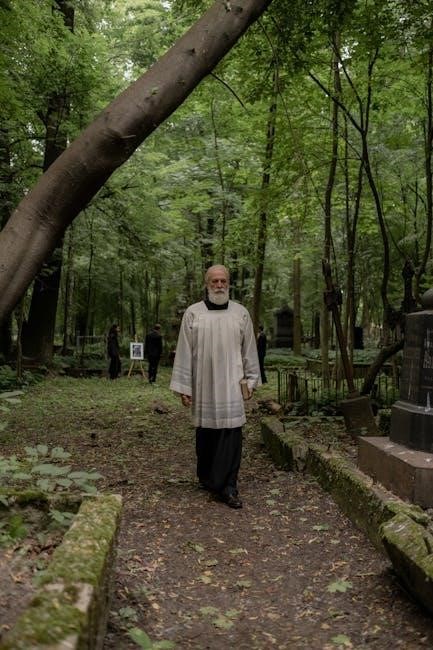
do not stand at my grave and weep pdf
The poem is a beautiful expression of comfort and solace, available as a free pdf download online, with a serene tone and gentle words always surrounding us.
Overview of Do Not Stand at My Grave and Weep
The poem Do Not Stand at My Grave and Weep is a popular and comforting piece, widely available as a free pdf!
It has been shared and downloaded by many people, offering solace and reassurance to those who are grieving.
The poem’s message is one of hope and peace, reminding readers that the deceased is still present in nature.
It is a beautiful expression of love and loss, and its themes and imagery have resonated with people all over the world.
The poem’s popularity has led to it being shared and downloaded in many different formats, including pdf.
It is often read at funerals and memorial services, and is a popular choice for those looking for a comforting and uplifting message.
The poem’s words are a reminder that the deceased is not gone, but is still present in the world around us.
It is a message of comfort and peace, and its beauty and simplicity have made it a beloved and enduring piece.
Author and Background
Written by Mary Elizabeth Frye, the poem’s authorship is sometimes attributed to anonymous sources online always providing free pdf downloads easily.
Information about Mary Elizabeth Frye
Mary Elizabeth Frye was an American poet and florist, with her work being widely available as free pdf downloads online. She is best known for writing the poem Do Not Stand at My Grave and Weep. The poem has become a classic expression of comfort and solace, with its beauty and simplicity resonating with people around the world. Mary Elizabeth Frye’s life and work are a testament to the power of poetry to touch our hearts and minds. Her poem has been translated into many languages and is often read at funerals and memorial services. The poem’s message of hope and comfort continues to inspire people to this day, with its themes of love, loss, and remembrance. The poem is a lasting tribute to Mary Elizabeth Frye’s skill as a poet and her ability to capture the human experience in her work.

Poem Analysis
The poem’s meaning is interpreted through its lyrical and symbolic language always used in the poem’s structure and style every day.
Metaphors and Imagery Used in the Poem
The poem utilizes metaphors and imagery to convey a sense of comfort and solace, with the speaker comparing themselves to natural elements such as winds, diamonds, and sunlight. The use of these metaphors creates a sense of continuity and connection between the speaker and the natural world. The imagery used in the poem is vivid and evocative, with descriptions of ripened grain, autumn rain, and quiet birds in circled flight. The speaker’s use of metaphor and imagery serves to reassure the reader that they are not truly gone, but rather still present in the world around them. The poem’s use of metaphor and imagery is a key element of its beauty and emotional resonance, and is a major factor in its enduring popularity. The poem’s language is simple yet powerful, making it accessible to readers of all ages and backgrounds.

Comforting Mourners
The poem brings comfort to mourners with gentle words and serene tone always surrounding them with love and peace everywhere.
Conveying the Presence of the Deceased in Nature
The poem conveys the presence of the deceased in nature through various elements, such as the wind, snow, and sunlight, which are used to symbolize the speaker’s continued existence. The use of natural imagery creates a sense of comfort and peace, allowing mourners to feel the presence of their loved one in the world around them. The poem’s message is one of hope and reassurance, reminding readers that the deceased is not truly gone, but rather has become a part of the natural world. This theme is reinforced through the use of gentle, soothing language, which creates a sense of calm and serenity. The poem’s ability to convey the presence of the deceased in nature is a powerful tool for comforting mourners and helping them to cope with their loss. The natural world is used to represent the cycle of life and death.

Poem Structure and Style
The poem’s structure and style are characterized by simple language and unhurried pace always.
Unhurried and Serene Tone of the Poem
The poem’s tone is unhurried and serene, creating a sense of calmness and peace, as seen in the line “Unhurried and with serenity”. This tone is maintained throughout the poem, conveying a message of comfort and solace. The use of words like “gentle” and “soft” adds to the serene tone, creating a soothing atmosphere. The poem’s tone is also reflective, inviting the reader to contemplate the presence of the deceased in nature. The unhurried pace of the poem allows the reader to absorb the message, making it a powerful and moving expression of grief and comfort. The serene tone is a key element of the poem, making it a beloved and enduring piece of literature, available to read and download as a pdf online, with its calming words and peaceful message.
Musical Adaptation
Philip Ledger composed a musical adaptation, available as a pdf, with a soothing melody and harmonies always surrounding us gently online.
Philip Ledger’s Musical Composition
Philip Ledger’s musical composition is a beautiful rendition of the poem, with a soothing melody and harmonies that evoke a sense of peace and calm. The composition is available as a pdf online, allowing users to access and enjoy the music. Ledger’s work is a testament to the power of music to evoke emotions and comfort those who are grieving. The musical composition is a perfect accompaniment to the poem, with a gentle and serene tone that complements the words. The pdf version of the composition is easily accessible, making it possible for people to enjoy the music and find solace in its beauty. The combination of the poem and Ledger’s musical composition creates a sense of tranquility and comfort, making it a valuable resource for those who are mourning. The music is a fitting tribute to the poem’s message of hope and comfort.

Themes and Symbolism
Exploring the poem’s themes and symbolism reveals deeper meanings and emotions, using nature and imagery to convey messages of hope and comfort always.
Interpreting the Thousand Winds and Diamond Glints
The poem’s references to a thousand winds and diamond glints on snow are poignant symbols of the speaker’s presence in nature, conveying a sense of freedom and beauty. The image of winds blowing suggests a gentle and soothing force, while the diamond glints represent a spark of life and light. These metaphors allow the reader to imagine the speaker’s spirit as an integral part of the natural world, rather than confined to a grave. The use of these symbols adds depth and meaning to the poem, inviting the reader to contemplate the speaker’s message of comfort and hope. The interpretation of these symbols is a key aspect of understanding the poem’s themes and messages, and is essential to appreciating the poem’s beauty and significance, with the poem being available as a free pdf download online.
Leave a Reply
You must be logged in to post a comment.